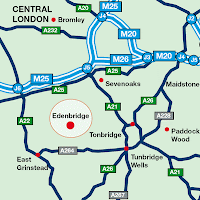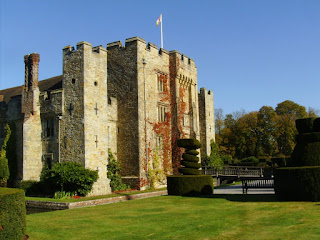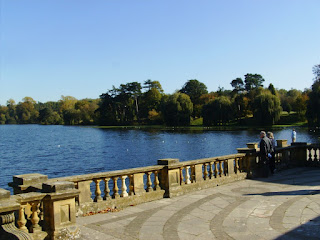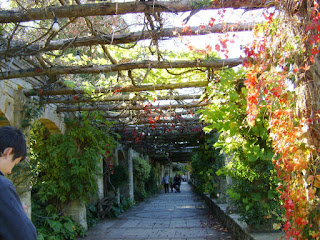
Hever Castle, located in lovely countryside south-east of London, is perhaps one of the most enchanting moated castles in Britain. Not only is the castle attractive from the outside, it is simply gorgeous inside, and it is steeped in the kind of history that everybody loves to hear—about the sordid activities of Henry VIII, and of Anne Boleyn, his second wife, who was beheaded.

The oldest part of the castle was built in 1270, and consisted of a massive gatehouse and walled Bailey surrounded by a moat (we could still see an excellent example of a portcullis when we went over the drawbridge). It wasn't until 1500 that the Boleyn family (then spelt Bollen) added a comfortable Tudor house inside the walls.

Anne Boleyn was born at Hever Castle in 1509, but she spent much of her childhood at court in France where her father, Sir Thomas Bollen, was an Ambassador. After the family's return to Hever, Anne was appointed lady-in-waiting to Queen Catherine of Aragon, Henry VIII's first wife, and thus she attracted the attention of the king.

When Henry proposed to Anne she reminded him that he already had a wife, and refused to be his mistress. This was a huge challenge to Henry who went against both the Church and the Law to marry Anne. He first removed England from the jurisdiction of the Pope and established the Church of England, with himself as Head; he suppressed the monasteries, and started the Reformation.

In January 1533 Anne and Henry were married, six months before his divorce was actually finalized, and Anne was already pregnant with the baby that was to be the future Queen Elizabeth I. However, Anne had several miscarriages and a still-born son, and Henry was outraged because he wanted a son and heir. On May 2, 1536, Anne was arrested and imprisoned in the Tower of London on a trumped-up charge of High Treason and later executed, so Henry was free to remarry.

Henry then murdered Anne's brother, appropriated Hever Castle and later gave it to another wife, Anne of Cleves, who owned it for the next 17 years. At her death it was bought by the family who became the 1st Baronet of Hever Castle, but from 1749-1903 it fell into disrepair until it was bought by the American millionaire, William Waldorf Astor.

The Astor family is a classic story of "rags to riches". In 1783 a butcher's boy named Johann Jakob Astor emigrated from Germany to America where he became a successful trapper. He eventually set up a trading base at the mouth of the Columbia River in north west Oregon which was named Astoria in his honour.
However, he became disillusioned with America, developed a passionate love for Europe, and took his fortune (estimated at $100 million) and moved to England. In 1903 he acquired Hever Castle and began to restore it, and, happily for his efforts, in 1916 he was created Viscount Astor, the 1st Baron of Hever Castle.
However, a problem arose in that the castle itself was too small for William Astor to both live in and entertain, therefore he decided to build a Tudor-style village for his guests,

Each house is distinct, built of different materials, in different shapes, angles and styles, the result being a series of charming individual cottages, which we could see from each side of the castle, joined by corridors and service areas. Finally, Viscount Astor combed the world for objects of art to decorate and furnish his castle, and the result is a treasure house of collections set in elaborately-decorated rooms, in many of which the plaster work and woodwork is incredibly and intricately beautiful.

Yet Hever Castle is a warm, friendly kind of castle in which we could actually imagine living a stately home which can be visited time and again when, each time, you are likely to discover something new. He created many gloriously colourful gardens of many different styles, most notably the Italian Garden, which leads down to a laggia at the lake.




William Astor died in 1919 but, fortunately, his family continued with his restorative work and also contributed enormously to charity. In 1963, the 2nd Baron Astor of Hever decided to open the castle to the public, and at his death the 3rd and present Baron, John Jacob, continued to do so, although the Tudor village remains private for guests at the many special functions which take place in the castle.

Anne and her father are buried in St. Peter's Church in Hever Village outside the castle.


For history buffs: the Tudor Long Gallery in Hever Castle features scenes from the life and times of Anne Boleyn; and the Astors of Hever Exhibition illustrates the important part the Astor family played in the restoration of the castle and gardens.
















